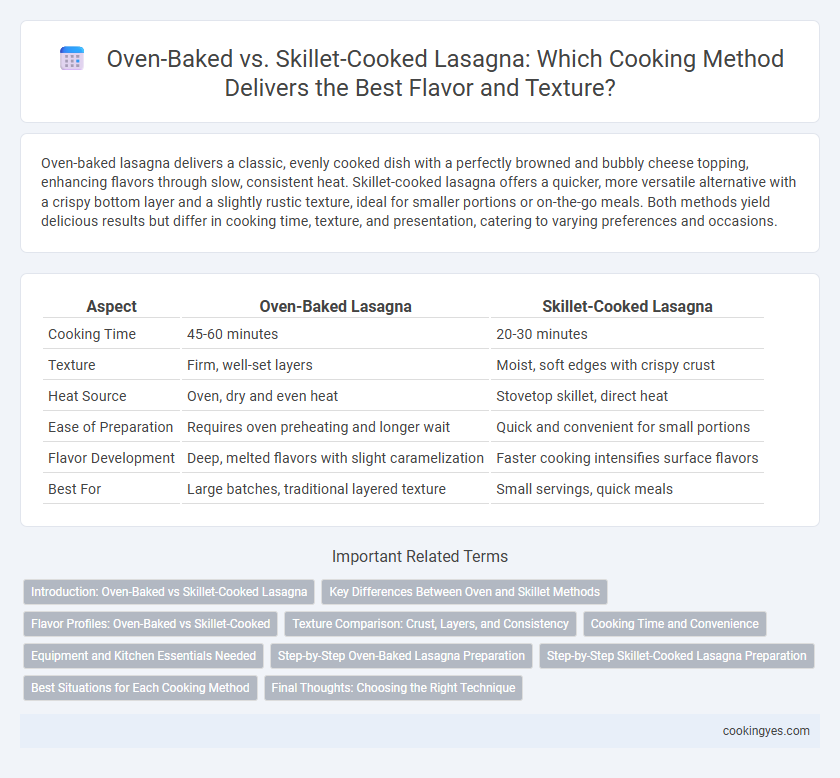Oven-baked lasagna delivers a classic, evenly cooked dish with a perfectly browned and bubbly cheese topping, enhancing flavors through slow, consistent heat. Skillet-cooked lasagna offers a quicker, more versatile alternative with a crispy bottom layer and a slightly rustic texture, ideal for smaller portions or on-the-go meals. Both methods yield delicious results but differ in cooking time, texture, and presentation, catering to varying preferences and occasions.
Table of Comparison
| Aspect | Oven-Baked Lasagna | Skillet-Cooked Lasagna |
|---|---|---|
| Cooking Time | 45-60 minutes | 20-30 minutes |
| Texture | Firm, well-set layers | Moist, soft edges with crispy crust |
| Heat Source | Oven, dry and even heat | Stovetop skillet, direct heat |
| Ease of Preparation | Requires oven preheating and longer wait | Quick and convenient for small portions |
| Flavor Development | Deep, melted flavors with slight caramelization | Faster cooking intensifies surface flavors |
| Best For | Large batches, traditional layered texture | Small servings, quick meals |
Introduction: Oven-Baked vs Skillet-Cooked Lasagna
Oven-baked lasagna offers even heat distribution, allowing layers of pasta, sauce, and cheese to meld perfectly with a golden, bubbly top. Skillet-cooked lasagna provides a quicker, stovetop method that delivers a crispier bottom layer and more pronounced caramelization. Choosing between these methods depends on desired texture and cooking time preferences.
Key Differences Between Oven and Skillet Methods
Oven-baked lasagna develops a rich, evenly melted cheese topping and a deeply browned crust due to gradual, consistent heat distribution, enhancing flavor complexity. Skillet-cooked lasagna offers faster preparation with a crispy, caramelized bottom layer and tender middle, as it cooks on direct stovetop heat, allowing for quicker meal turnaround. Texture varies significantly; oven baking yields uniform softness while skillet cooking creates contrasting textures between crispy and gooey layers.
Flavor Profiles: Oven-Baked vs Skillet-Cooked
Oven-baked lasagna develops a rich, melded flavor as the layers of cheese, sauce, and pasta slowly caramelize and meld together, resulting in a crispy golden top and evenly cooked interior. Skillet-cooked lasagna offers a more pronounced contrast in textures, with a slightly crispy bottom crust and a quicker sauce reduction that intensifies tomato and herb notes. The oven method emphasizes even heat distribution for a cohesive, tender bite, while skillet preparation enhances bold, concentrated flavors with a satisfying crisp texture.
Texture Comparison: Crust, Layers, and Consistency
Oven-baked lasagna develops a golden, crispy crust with distinct, well-set layers that provide a firm yet tender bite, allowing flavors to meld evenly throughout the dish. Skillet-cooked lasagna often results in a softer crust and slightly less-defined layers, producing a creamier consistency with more moisture retention. The choice between the two methods impacts the balance of a crisp exterior versus a rich, tender interior.
Cooking Time and Convenience
Oven-baked lasagna typically requires 45 to 60 minutes of cooking time but allows for even heat distribution, resulting in a richly layered and evenly melted cheese texture. Skillet-cooked lasagna cuts cooking time to about 20 to 30 minutes and offers increased convenience by combining sauteing and simmering steps in one pan, making it ideal for quick meals or smaller portions. Both methods yield delicious results, with oven baking favored for large, traditional recipes and skillet cooking preferred for faster preparation and easier cleanup.
Equipment and Kitchen Essentials Needed
Oven-baked lasagna requires a sturdy, oven-safe baking dish like glass or ceramic, along with an oven preheated to 350-375degF for even cooking and melting of cheese layers. Skillet-cooked lasagna demands a large, deep, oven-proof skillet or cast iron pan to accommodate layering and stovetop simmering before finishing in the oven or under a broiler. Both methods benefit from essential kitchen tools such as a sharp knife for slicing, spatulas for layering, and heat-resistant mitts for safe handling of hot cookware.
Step-by-Step Oven-Baked Lasagna Preparation
Oven-baked lasagna requires layering cooked pasta sheets, ricotta cheese, meat sauce, and mozzarella in a baking dish, followed by covering with foil to prevent drying. Baking at 375degF (190degC) for 45 minutes ensures even cooking and bubbling cheese, with the foil removed in the last 10 minutes for a golden crust. This method guarantees a perfectly melded texture and deep, rich flavors compared to skillet-cooked alternatives.
Step-by-Step Skillet-Cooked Lasagna Preparation
Skillet-cooked lasagna involves layering cooked noodles, seasoned meat sauce, and cheese directly into a large skillet, starting with a thin layer of sauce to prevent sticking. Each layer is added carefully, ensuring even distribution before topping with mozzarella and covering with a lid to allow the lasagna to steam and meld over medium heat for 15-20 minutes. This method offers quicker cooking time compared to oven-baking, with a crusty bottom and moist interior, ideal for efficient meal preparation.
Best Situations for Each Cooking Method
Oven-baked lasagna is ideal for achieving evenly cooked layers with a golden, bubbly cheese crust, making it perfect for large gatherings or meal prepping. Skillet-cooked lasagna suits quick, small-batch meals where convenience and faster cooking times are prioritized without sacrificing flavor. For best results, use the oven method for traditional, deeply melded flavors and the skillet method for a crispy bottom and slightly charred texture.
Final Thoughts: Choosing the Right Technique
Oven-baked lasagna offers evenly cooked layers with a golden, bubbly top and a traditional texture that many prefer for a classic meal experience. Skillet-cooked lasagna provides a quicker option with a crispier bottom and a slightly caramelized flavor, ideal for smaller portions or a stovetop convenience. Selecting the right technique depends on desired texture, cooking time, and available equipment, ensuring a perfect lasagna tailored to personal taste and kitchen setup.
Oven-baked vs Skillet-cooked for preparation Infographic

 cookingyes.com
cookingyes.com